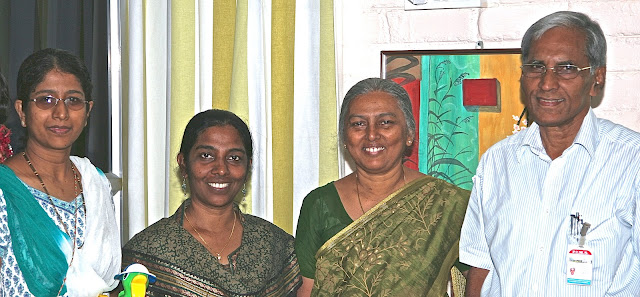A week is not just seven days in the calendar or in the chronology of our lives. Each day is full of happenings which shape our lives and form our character.
The week began with an unknown car bumping into our parked car, in the parking area causing a dent. The next day the water level dropped suddenly in the open well at our cottage, that we could not pump water into the overhead tank. A carpenter arrived, after a waiting for six months, to assemble the two cupboards, which we brought with us in a dismantled state form Pondicherry. One packet of special screws was missing, which delayed the work. It was after several years, we were not able to join the holy week evening services as the church we go to, is about an hour journey and it was not possible to go leaving my mother alone at night. The whether has turned hot and humid and yesterday's temperature was 42 degree celsius during mid-day. I had a fall today leaving me with some bruises.
At the end of the week, what strikes me is this photograph, which I used once for an earlier blog. It is a bunch of most delicate flowers, which has often drawn my attention whenever I notice them. They are colourful, pretty, open fully in sunlight and last for about ten days or so. They bloom in the winter months when the day time temperature is low and the nights are cooler. They adapt to extreme climates also. These flowers although are delicate, do not suffer much damage in wind or rain as they sway or adapt well to the stress of the wind or rain. A botany teacher told me that its stalk and the stem are strong.
It is this the Easter message reminds us of. There is enabling and overcoming grace from God in all circumstances. Anna and I did feel the stress; but as we come to the end of the week, there is strength, encouragement and hope.
This wave of encouragement swept through our soul, when a young doctor drove us to the garage to collect the car after repair and later visited us at our cottage. He was most appreciative of the rural setting and nature's bounty around our cottage, with a stream meandering through our property and the house overlooking acres of paddy field and coconut palms and surrounded by wooded properties. He lifted our spirit as he described what he saw. He enthused us by his fervour for nature and its grace of beauty and serenity. He was certainly sent for our encouragement and comfort.
We remembered then, St. Paul's words, in I Corinthians, 10:13, '..God will not suffer you to be tempted above you are able, but with it will send the grace to endure it..'
A pilgrims's journey is seasoned with challenges and comfort.
M.C.Mathew(text and photo)










